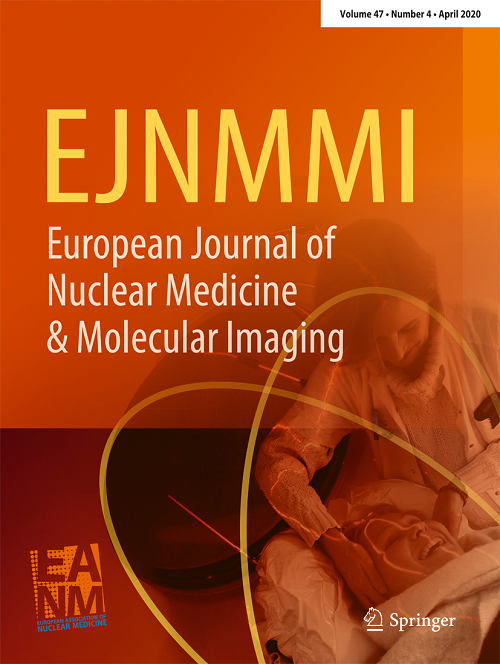[18F]FDG PET/CT在腹膜后纤维化治疗监测及进展预测中的应用。
IF 7.6
1区 医学
Q1 RADIOLOGY, NUCLEAR MEDICINE & MEDICAL IMAGING
European Journal of Nuclear Medicine and Molecular Imaging
Pub Date : 2025-08-14
DOI:10.1007/s00259-025-07479-6
引用次数: 0
摘要
目的腹膜纤维化(RPF)是一种罕见的炎症性疾病,如果不及时治疗,可导致输尿管梗阻和随后的肾脏损害。一线治疗是强的松龙和利妥昔单抗,常用于难治性病例。本研究评估了[18F]FDG PET和CT的治疗反应,以及早期预测进展的潜在基线参数。方法50例RPF患者接受了至少两次[18F]FDG PET/CT扫描(基线,BL和第一次随访,FU1), 36例患者进行了第二次随访(FU2), 18例患者进行了第三次随访(FU3)。测量腹膜后肿物的PET参数SUVmax、SUVmean、SUVpeak、代谢活性体积(MAV)、厚度(CTrim)和颅尾延伸(CTcc)。治疗组分为强的松龙、利妥昔单抗和两者联合。结果4个时间点PET参数与CTrim均有显著相关性。治疗后各项PET参数及CTrim均显著降低(p≤0.021)。强的松龙组和联合治疗组的代谢和形态学反应显著(p≤0.003)。在FU2时,8例患者出现进展,MAV是BL进展的良好预测因子(p = 0.041;217.33 vs 100.86 ml)。在FU2时,SUVmax、SUVpeak和MAV在进展组和非进展组之间差异有统计学意义(p≤0.009),而CT显示差异无统计学意义。结论PET在RPF治疗监测方面优于CT,特别是在FU2进展检测方面。较高的BL MAV与FU2的进展相关,表明其作为预测标志物的潜力。尽管如此,特别是在PET无法获得的情况下,CT可以考虑作为初始治疗监测。本文章由计算机程序翻译,如有差异,请以英文原文为准。
[18F]FDG PET/CT for treatment monitoring and prediction of progression in retroperitoneal fibrosis.
PURPOSE
Retroperitoneal fibrosis (RPF) is a rare inflammatory disease, that, if left untreated, can lead to ureteral obstruction and subsequent renal impairment. First-line treatment is prednisolone, with rituximab, often used for refractory cases. This study evaluates treatment response in both [18F]FDG PET and CT, and potential baseline parameters for early prediction of progression.
METHODS
50 patients with RPF underwent at least two [18F]FDG PET/CT scans (baseline, BL, and first follow-up, FU1), 36 patients a second (FU2), 18 patients a third follow-up (FU3). PET parameters SUVmax, SUVmean, SUVpeak, metabolic active volume (MAV), thickness (CTrim) and cranio-caudal extension (CTcc) of the retroperitoneal mass were measured. Therapy groups were divided into prednisolone, rituximab and the combination of both.
RESULTS
All PET parameters showed significant correlations with CTrim at all four timepoints. After therapy all PET parameters and CTrim decreased significantly (p ≤ 0.021). Highly significant metabolic and morphologic response was seen in the prednisolone (p ≤ 0.003) and the combination therapy group (p ≤ 0.001). At FU2, eight patients showed progression, with MAV as a good predictor of progression in BL (p = 0.041; 217.33 versus 100.86 ml). At FU2, SUVmax, SUVpeak and MAV differed significantly between progression and non-progression group (p ≤ 0.009), while CT showed no significant differences.
CONCLUSION
Our findings underscore the superiority of PET against CT in therapy monitoring of RPF, especially in the detection of progression at FU2. Higher BL MAV correlated with progression at FU2, indicating its potential as a predictive marker. Still, especially when PET is not available, CT can be considered for initial therapy monitoring.
求助全文
通过发布文献求助,成功后即可免费获取论文全文。
去求助
来源期刊
CiteScore
15.60
自引率
9.90%
发文量
392
审稿时长
3 months
期刊介绍:
The European Journal of Nuclear Medicine and Molecular Imaging serves as a platform for the exchange of clinical and scientific information within nuclear medicine and related professions. It welcomes international submissions from professionals involved in the functional, metabolic, and molecular investigation of diseases. The journal's coverage spans physics, dosimetry, radiation biology, radiochemistry, and pharmacy, providing high-quality peer review by experts in the field. Known for highly cited and downloaded articles, it ensures global visibility for research work and is part of the EJNMMI journal family.

 求助内容:
求助内容: 应助结果提醒方式:
应助结果提醒方式:


